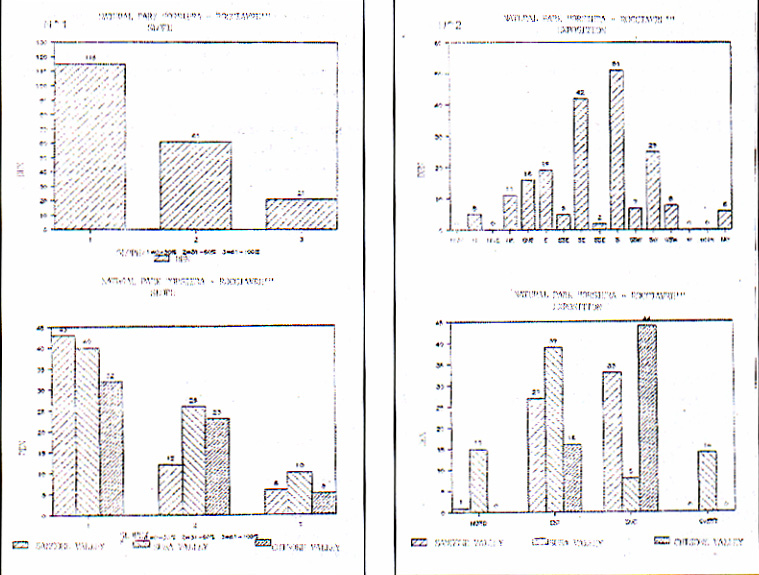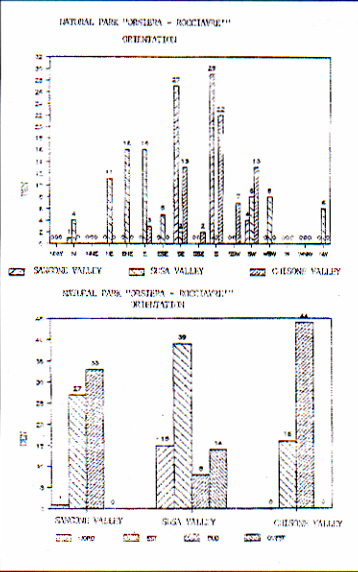Bassano B., Durio P., Gallo Orsi U., Macchi E
eds., 1992. Proceedings of the 1st Int. Symp. on
Alpine Marmot and genera Marmota. Torino.
Edition électronique, Ramousse R., International Marmot Network, Lyon 2002
THE POPULATION OF MARMOT (Marmota marmota) IN THE NATURAL PARK ORSIERA ROCCIAVRÈ
LA POPOLAZIONE DI MARMOTTA (Marmota marmota) NEL PARCO NATURALÉ ORSIERA ROCCIAVRÉ
Vita A.
Parco Naturale "Orsiera-Rocciavre"-Pra Catinat. 10060 Fenestrelle (Torino- Italy)
Abstract - The author, warden of the Park, has carried out a research on the population of Marmot in the Park. The protected area includes the masisif of Mont Orsiera and Mont Rocciavr located between Chisone, Susa and Sangone valleys. The aim of the research has been to draw a map of the zones haunted by the Marmot. The position (orientation, altitude, slope) and their distribution on the territory have been studied. In some areas botanical aspects were considered.
The preliminary results show a correlation between the presence of the marmots and rich floristical pasture tipology. The species probably have a role as environmental indicator.
The Park covers an area of about 1l,000 hectars and includes the homonymous mountains along the watershed between the Chisone, Susa and Sangone valleys.
The typology of the rocks varies from calcareus to serpentine. The 1andscape shows the typical shapes of glacial modelling with ciques and deep valley, morainal relief and lakes.
MATERIALS AND METHODS
- Fields glasses, Compass, altimeters;
- Camps in altitudes to collect the general data;
- Signalling forms;
- Direct talks with co11eagues of work.
For each den the following data were collected:
- Orientation;
- Slope;
- Tipology of the soil;
- Altitude.
Period of research:
- Three summer seasons.
FLORISTICAL SPECIES PRESENT IN THE ALPINE PRAIRIES WITH MARMOT COLONIES
Phleum alpinum
Festuca rubra
Trifolium sp.
Poligonum bistorta
Poligonum viviparum
Alchemilla vulgaris
Alchemilla pentaphyllea
Rumex sp.
Brachipodium pinnatum
Poa pratensis
Argostis sp.
Leontodon sp.
Salix herbacea
Alchemilla pentaphyllea
Soldanella sp.
Lotus alpinus
Plantago alpina
Taraxacum officinale
PREDOMINANT SPECIES IN THE PRAIRIES WHERE THE MARMOTS ARE ABSENT
Nardus stricta
Carex sempervirens
Carex curvula
Sesleria sp.
The marmot's population in the Park has a good vitality. The area visited has showed to be constantly frequented and the colonies were active with a good reproductivity testified by constant sightings of youngs.
The diffusion of the species in Susa and Chisone valleys is rather uniform, while in Sangone valley the frequented zones are concentrated in the alpine postures.
In some valleys, despite having good parameters (slope, exposure and altitude) marmots are absent or have disappeared as showed by dens no longer frequented. In these zones the predominant botanical species are Nardus, Carex sp. and Sesleria sp.
The intensive and unruled grazing of domestic animals (cattle, sheep and goat) that takes place in summer i.e. during the period of greater marmot's activity, is the cause of the impoverishment and the progressive abandoning of the examinated zones. In a situation where environmental conditions (snow cuver, low temperature) play a very important role, the over-grazing in the high postures deeply affects the survival possibilities of the colonies limiting the reproductive potentiality. The marmot have a social organization and a survival strategy adapted to a such difficult environment that her presence or absence may be used as an environmental indicator of the ecological balance of alpine prairies.
LA POPOLAZIONE DI MARMOTTA (Marmota marmota) NEL PARCO NATURALÉ ORSIERA ROCCIAVRÉ
Vita A.
Parco Naturale "Orsiera-Rocciavre"-Pra Catinat. 10060 Fenestrelle (Torino- Italy)
Il Parco copre un'area di circa 11.000 ettari ed include le omonime montagne poste lungo lo spartiacque fra le Valli Chisone, Susa e Sangone. La tipologia delle rocce varia dalle calcaree alle serpentinose.
Il paesaggio mostra caratteristiche forme di modellamento glaciale con circhi e valloni, rilievi morenici e laghi.
Materiali e metodi
- Binocolo, bussola, altimetro
- Campi in quota per raccolta dati complessivi
- Schede di segnalazione
- Dialoghi diretti con colleghi di lavoro;
- Per ogni tana sono stati misurati i parametri:
- orientamento
- inclinazione del pendio
- tipologia del terreno
- altitudine
Durata della ricerca:
- tre stagioni estive.
Specie floristiche presenti nelle praterie alpine con colonie di marmotta
Phleum alpinum
Festuca rubra
Trifolium sp.
Poligonum bistorta
Poligonum viviparum
Alchemilla vulgaris
Alchemilla pentaphyllea
Rumex sp.
Brachipodium pinnatum
Poa pratensis
Argostis sp.
Leontodon sp.
Salix herbacea
Alchemilla pentaphyllea
Soldanella sp.
Lotus alpinus
Plantago alpina
Taraxacum officinale
Specie predominanti nelle praterie dove le marmotte sono assenti
Nardus stricta
Carex sempervirens
Carex curvuka
Sesleria sp.
La popolazione di marmotte nel Parco ha una buona vitalità .
Le aree visitate si sono dimostrate costantemente frequentate e le colonie arrive con un buon successo riproduttivo testimoniato dal costante avvistamento di piccoli.
La diffusione della specie nelle valli di Susa e Chisone è piuttosto uniforme, mentre nella Val Sangone le zone frequentate sono concentrate attorno agli alpeggi.
In alcuni valloni, sebbene con buoni parametri (pendenza, esposizione ed altitudine), le marmotte sono assenti o sono scomparse come mostrato dalle tane non più frequentate. In queste zone le specie botaniche predominanti sono Nardus, Carex sp. e Sesleria sp. Il pascolo intensivo ed incontrollato degli animali domestici (bovini, ovini e caprini) durante il periodo estivo, cioé durante il periodo di maggiore attività delle marmotte, è la causa dell'impoverimento e del progressivo abbandono delle zone esaminate. In un contesto dove le condizioni ambientali (copertura nevosa, basse temperature) giocano un ruolo molto importante, il sovraccarico di animali domestici sui pascoli in quota si riflette pesantmente sulle possibilità di sopravvivenza delle colonie, limitandone le potenzialità riproduttive. Per questo la Marmotta, con la sua organizzazione sociale e le strategie per vivere adattate ad un ambiente cosi difficile, puo essere considerato, attraverso la sua presenza - assenza, un indicatore ambientale dell'equilibrio ecologico delle praterie alpine.
Â
Â
Â
REFERENCE
ARMITAGE K.B. - DOWNHOWER (1970). Interment behavior in the yellow-bellied Marmot. Journal of Mammology, vol. 51(1): 177-178.
ARNOLD W. (1985). Socioecology of Alpine Marmots. Abstracts of spoken and poster papers 19th Intemational Etological Conference 24-28/8/1985 Univ. P. Sabatier Toulouse, FRANCE - vol 1.
ARMITAGE K.B. (1976). Scent marking by yellow-bellied Marmots. Journal of Mammology, 57(3)Â : 583-584.
ARCHIVIO PARCO NAT. ORSIERA - ROCCIAVRE (1984-1988). Studio preliminare per il miglioramento dei pascoli. A cura dello Studio Agronomico ODASSO-ROTA.
BOPP P. (1954). Zur Topographie der Murmeltierterritorien. Rev. Suisse Zool., 61: 374-380.
BOPP P. (1955). Kolonialterritorien bei Murmeltieren. Rev. Suisse Zool., 62: 295-299.
BOPP P. (1956). Zur Topographie eines Kolonelterritoriums bei murmeltieren. Rev. Suisse Zool., 63: 255-261
CAGNOLARO L., SPAGNESI M. (1981). Marmotta. Distribuzione e biologia di 22 specie di mammiferi in Italia. Progetto Finalizzato: Promozione della qualità dell~ambiente Linea di ricerca: Censimento delle specie rare e minacciate". C.N.R. - Roma.
COUTURIER M. (1964). La Marmotte des Alpes. Le Gibier des montagnes francaises. Ed. Arthaud.
DURIO P., BASSANO B., PERRONE A. (1987). Le tane della Marmotta. da La Marmotta alpina-Ente Parco Nazionale Gr. Paradiso 1987.
GRZIMECK (1974). Vita degli animali. Ed. Bramante, Milano vol. ll, pag. 249-270.
LANFRANCHI P. (1987). Alcune considerazioni di ordine parassitologico sulla marmotta. Da La Marmotta Alpina, Parco Naz.le Gr. Paradiso 1987.
LENTI D. (1987). Caratteristiche degli insediamenti e stima della densità di Marmota alpina in zona campione del Parco naz.le del Gran Paradiso da La marmotta alpina, Parco Naz.le Gran Paradiso 1987
PIGOZZI G. (1984). The den system of the Alpine marmot (Marmota Marmota Marmota) in the National Park of Stelvio, Northern Italy. Sonderdruck dus Z. f. Saugetierkunde Bd., 49~ H. l~S. 13-21
SVENDSEN G.E. (1974). Behavioral and environmental factors in the spatial distribution and population dynamics of a yellow-bellied Marmot population. Ecology, 55~ 760-771.
TONGIORGI P. et al. (1988). Indagini sul popolamento di marmotta del crinale appenninico Tosco-Emiliano. Univ. di Modena e Amm.ne Prov.le di Modena.
WARD J.M. Jr., ARMITAGE K.B. (1981). Water budgets of Montane-Mesic and Lowland-Xeric populations of Yellow-bellied Marmots. Comp. Biochem. Physiol., vol. 69a: 627-630.
ZELENKA G. (1965). Observations sur l’écologie de la marmote des Alpes. Terre et vie, 19: 238-256.
DENSITY ESTIMATE IN THE NATURAL PARK ORSIERA-ROCCIAVRÈ
|
Park Surface |
10920 ha |
 |
|
Suitable area |
5274.2 ha |
(48.30 %) |
|
Used area |
1253 ha |
(11.4 %) |
|
Density on suitable area |
(4.7/100ha) |
 |
|
Density on used area |
(20/100ha) |
 |
Â
DENSITÀ STIMATA NEL PARCO NATURALE ORSIERA ROCCIAVRÈ
|
Superficie del Parco |
10920ha |
 |
|
Area vocata alla specie |
5274,2 ha |
(48,30 %) |
|
Area utilizzata |
1253 ha |
(11,40 %) |
|
Densità rispetto all'area vocata |
4,7/100 ha |
 |
|
Densità rispetto all~area utilizzata |
20/100 ha |
 |
Figure 1. Slope and exposition

ritorno/back
Figure 2.Orientation

ritorno/back
Tornare index / back contents
Â

